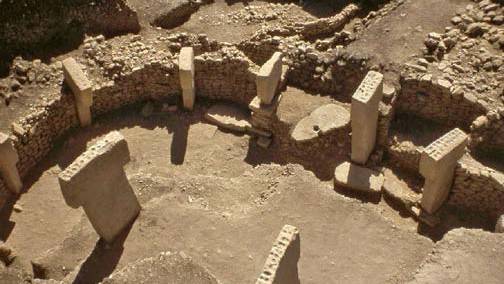Part 1: 12,000-Year-Old Gobekli Tepe - Is It Linked to the Star Deneb in the Cygnus Constellation?
Source: earthfiles.com
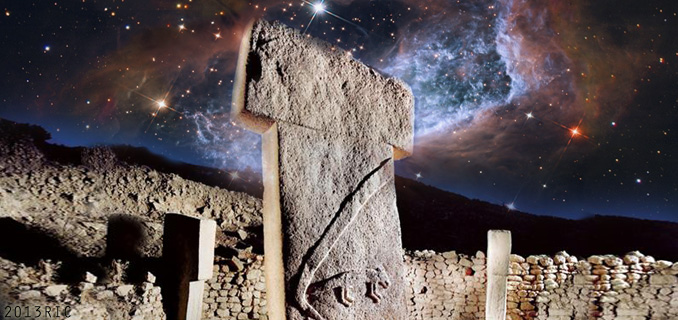
“What was so important to these early people that they gathered
to build (and bury) the stone rings? The gulf that separates us
from Gobekli Tepe’s builders is almost unimaginable.”
- Smithsonian Reporter Andrew Curry
“If you start looking into the religious ideas of cultures
and indigenous civilizations, you’ll find that the star Deneb, Cygnus constellation, in the Milky Way’s Dark Rift was seen as a point of entry and exit into the sky world. It was seen as this is where the souls came from and this is where the souls return to in death.”
- Andrew Collins, Author, The Cygnus Mystery © 2006/2007
March 29, 2013 Gobekli Tepe 8 miles northeast of Sanliurfa, Turkey -
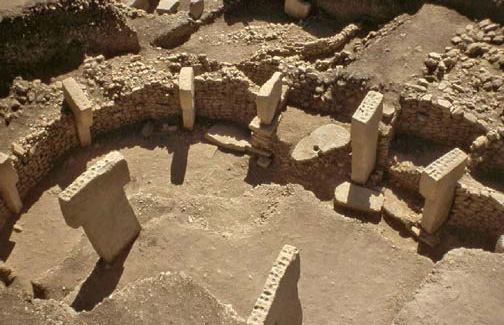
12,000-year-old circles of limestone pillars each weighing from 10 to 20 metric tons
or more have been excavated in Gobekli Tepe, Turkey, about 9 miles (15 km) northeast
of Sanliurfa, formerly known as Urfa or Edessa. More than twice the age of Mesopotamia,
40 standing T-shaped columns have so far been revealed in four circles between 30 feet
and 98 feet (10 to 30 meters) in diameter. Ground-penetrating radar indicates there
are still 250 more pillars buried in 16 circles extending over another 22 acres
of the 30-acre Neolithic site. Image © 2008 by Haldun Aydingun.
or more have been excavated in Gobekli Tepe, Turkey, about 9 miles (15 km) northeast
of Sanliurfa, formerly known as Urfa or Edessa. More than twice the age of Mesopotamia,
40 standing T-shaped columns have so far been revealed in four circles between 30 feet
and 98 feet (10 to 30 meters) in diameter. Ground-penetrating radar indicates there
are still 250 more pillars buried in 16 circles extending over another 22 acres
of the 30-acre Neolithic site. Image © 2008 by Haldun Aydingun.
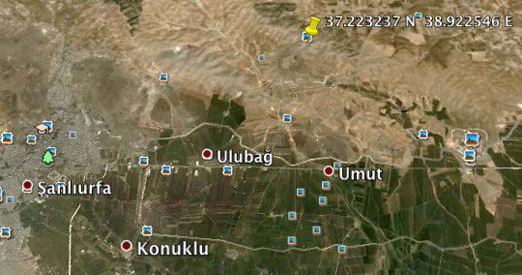
Yellow marker at coordinates for Gobekli Tepe: 37.223237 N, 38.922546 E
Gobekli Tepe in Turkish means “Potbelly Hill,” an archaeological site nine miles
northeast of Sanliurfa not far from the Syrian border. The region’s water comes
from the Euphrates, the longest river of Western Asia, that originates
upstream from Keban, Elazig Province in eastern Turkey.
Gobekli Tepe in Turkish means “Potbelly Hill,” an archaeological site nine miles
northeast of Sanliurfa not far from the Syrian border. The region’s water comes
from the Euphrates, the longest river of Western Asia, that originates
upstream from Keban, Elazig Province in eastern Turkey.
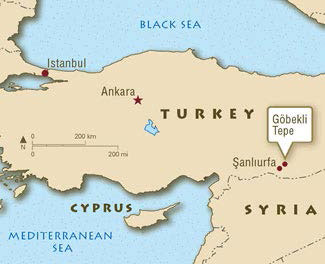
On Wednesday, June 13, 2012, as the sun rose I was standing on the Gobekli Tepe hilltop in southern Turkey not far from the Syrian northern border. Carbon dated to 12,000 years ago, Gobekli is older than Egypt, Sumeria, classical Greeks and Stonehenge. I had hoped, expected, that being there physically would help me understand the function of the mysterious 12,000-year-old rings of tall, T-shaped, oddly carved limestone pillars. But instead of understanding, I felt something alien, incomprehensible and disturbing.
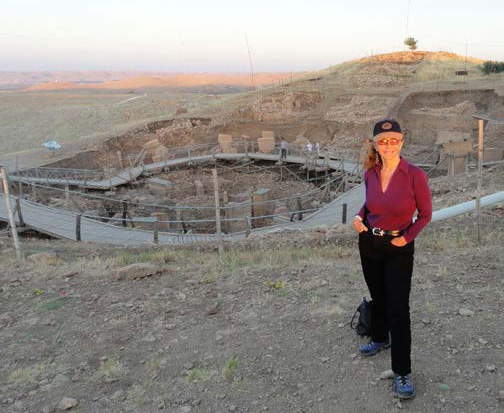
Earthfiles Reporter and Editor Linda Moulton Howe at June 13, 2012, sunrise
on the Gobekli Tepe hill excavation 8 miles northeast of Sanliurfa, Turkey. German archaeologist
Klaus Schmidt began scraping away dirt from the hill in 1994. His dig’s careful carbon
dating and soil compression analysis - combined with ground-penetrating radar - have
revealed nearly 300 thin, elegant, T-shaped limestone pillars were placed 12,000
years ago in circles covering 30 acres. Then a thousand years later, the entire
mysterious site was covered back over with soil for unknown reasons until it was
uncovered again in 1994 by Klaus Schmidt. Image by James Sorensen for Earthfiles.com.
on the Gobekli Tepe hill excavation 8 miles northeast of Sanliurfa, Turkey. German archaeologist
Klaus Schmidt began scraping away dirt from the hill in 1994. His dig’s careful carbon
dating and soil compression analysis - combined with ground-penetrating radar - have
revealed nearly 300 thin, elegant, T-shaped limestone pillars were placed 12,000
years ago in circles covering 30 acres. Then a thousand years later, the entire
mysterious site was covered back over with soil for unknown reasons until it was
uncovered again in 1994 by Klaus Schmidt. Image by James Sorensen for Earthfiles.com.
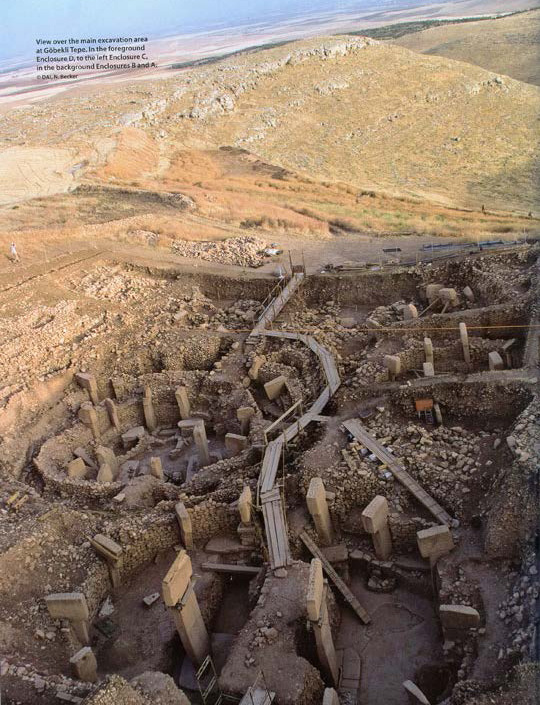
Google Earth coordinates for Gobekli excavation site: 37.223237 N, 38.922546 E
View over the main excavation area at Gobekli Tepe. In the foreground Enclosure D,
to the left Enclosure C, in the background Enclosures B and A. Image © 2012 by DAI,
N. Becker, Summer 2012 Issue 02 of Actual Archaeology Magazine-Anatolia,
“The First Temple of the World: Gobekli Tepe.”
View over the main excavation area at Gobekli Tepe. In the foreground Enclosure D,
to the left Enclosure C, in the background Enclosures B and A. Image © 2012 by DAI,
N. Becker, Summer 2012 Issue 02 of Actual Archaeology Magazine-Anatolia,
“The First Temple of the World: Gobekli Tepe.”
Ramps have been built to walk around the archaeological excavations of mysterious 10 to 19-foot-tall, elegantly carved T-shaped limestone pillars placed carefully in circular patterns. Each pillar weighs 10 to 20 metric tons. Many are sculpted with odd, even unrecognizable, animals, insects and humanoid figures. The unusual limestone pillars were quarried from bedrock pits located around 100 meters (330 ft) from the Gobekli hilltop.
Ground-penetrating radar has revealed nearly 300 thin, elegant, T-shaped limestone pillars were placed 12,000 years ago in circles covering 30 acres a thousand feet above the valley floor. Then a thousand years later, the entire mysterious site was covered back over with soil for unknown reasons until it was uncovered again in 1994 by Klaus Schmidt. Since then only 5% of the Gobekli Hill has been excavated.
To his surprise, archaeologist Klaus Schmidt did not find evidence of cooking hearths, houses or trash pits, and no clay fertility figurines. He found some stone hammers and blades, but no specific tools that could explain how the extraordinary 3-dimensional sculptures were made.
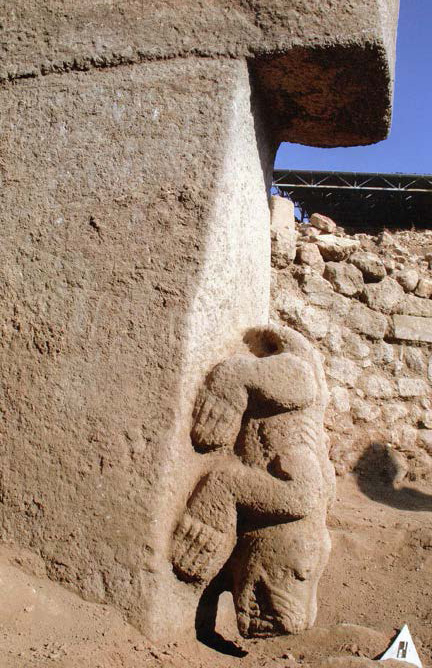 >
>Another reporter who sensed the alien quality of Gobekli Tepe was Smithsonian magazine reporter Andrew Curry, during his visit to Gobekli Tepe in 2008. He wrote, “Predating Stonehenge by at least 6,000 years, Turkey’s stunning Gobekli Tepe upends the conventional view of the rise of civilization” far earlier than the academically acceptable timeline of Mesopotamia 5,000 years ago. “What was so important to these early people that they gathered to build (and bury) the stone rings? The gulf that separates us from Gobekli Tepe’s builders is almost unimaginable. Indeed, though I stood among the looming megaliths eager to take in their meaning, they didn’t speak to me. They were utterly foreign, placed there by people who saw the world in a way I will never comprehend. There are no sources to explain what the symbols might mean. Schmidt agrees, ‘We’re 6,000 years before the invention of writing here.’’’
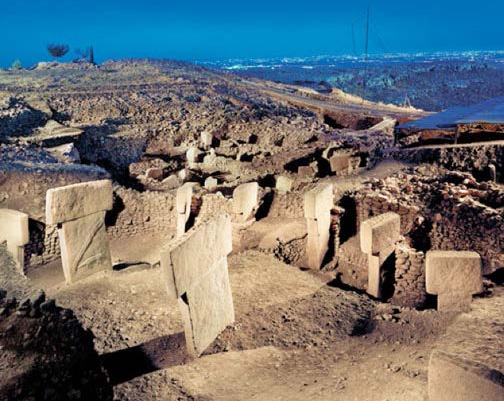
Gobekli Tepe Enclosure D photographed at night with Urfa city lights
in background © 2008 by Smithsonian Magazine.
in background © 2008 by Smithsonian Magazine.
So who placed sophisticated, carved limestone pillars on 30 some acres of the Gobekli Tepe hilltop twelve thousand years ago? And why? Why was the entire Gobekli site deliberately covered over with dirt a thousand years after its construction as if to protect it from – what? Did the original Gobekli creators have foreknowledge about a coming catastrophe? Did Someone with advanced technology rapidly re-bury all the pillars?
The effort needed to erect so many large stone circles over some 30 acres - and then have to bury all those pillars again centuries later – is beyond understanding.
U. K.’s Andrew Collins Finds Link
to Cygnus Constellation
 Also haunted by these questions is Andrew Collins, author of The Cygnus Mystery © 2006 U.K. and 2007 U. S. Other books include Beneath the Pyramids © 2009; and Ashes of Angels © 1996. Andrew has been exploring the history of ancient religious beliefs and their relationship to the universe for more than thirty years. He first traveled to Gobekli Tepe in 2004 and was so provoked by the strange limestone pillars that he began to work with engineer Rodney Hale, who has studied star alignments with prehistoric and sacred sites around the world. From their work together, Andrew is producing a new book to be released by Fall 2013 entitled Gobekli Tepe: Genesis of the Gods (Inner Traditions). In a prelude to the upcoming book, Andrew Collins summarized some of his new work at his website, andrewcollins.com, in a March 2013 article, Gobekli Tepe, Its Cosmic Blueprint Revealed. See Websites below.
Also haunted by these questions is Andrew Collins, author of The Cygnus Mystery © 2006 U.K. and 2007 U. S. Other books include Beneath the Pyramids © 2009; and Ashes of Angels © 1996. Andrew has been exploring the history of ancient religious beliefs and their relationship to the universe for more than thirty years. He first traveled to Gobekli Tepe in 2004 and was so provoked by the strange limestone pillars that he began to work with engineer Rodney Hale, who has studied star alignments with prehistoric and sacred sites around the world. From their work together, Andrew is producing a new book to be released by Fall 2013 entitled Gobekli Tepe: Genesis of the Gods (Inner Traditions). In a prelude to the upcoming book, Andrew Collins summarized some of his new work at his website, andrewcollins.com, in a March 2013 article, Gobekli Tepe, Its Cosmic Blueprint Revealed. See Websites below.We talked recently about his and Rodney Hale’s calculations that there is a consistent orientation of the larger central twin pillars in two of the stone pillar enclosures referred to as “C” and “D” excavated so far. That orientation 12,000 years ago would have been on the bright star Deneb in the Cygnus constellation, also known as the Northern Cross, and depicted as a flying swan by many ancient cultures.
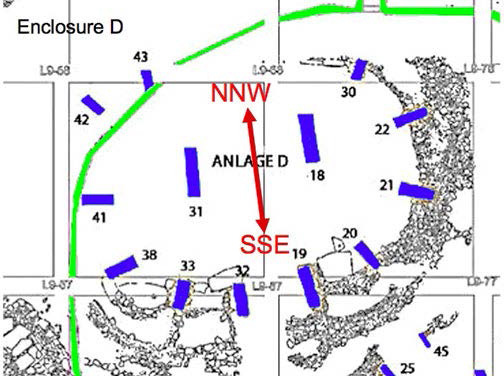
NNW orientation diagram of Gobekli Tepe Enclosure D by Andrew Collins
and Rodney Hale from March 2013 article, Gobekli Tepe, Its Cosmic
Blueprint Revealed. See AndrewCollins.com.
and Rodney Hale from March 2013 article, Gobekli Tepe, Its Cosmic
Blueprint Revealed. See AndrewCollins.com.
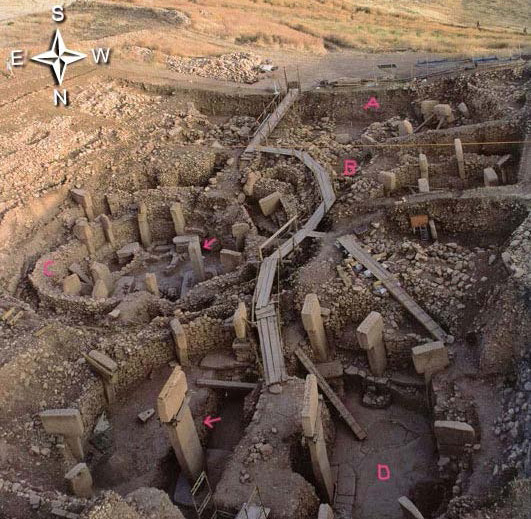
South (top), West (right), North (bottom) and East (left) view over the main excavation
area at Gobekli Tepe. In the foreground Enclosure D, to the left Enclosure C, in the
background Enclosures B and A. Image © 2012 by DAI, N. Becker, June 2012 issue
of Actual Archaeology Magazine-Anatolia, “The First Temple of the World: Gobekli Tepe.”
area at Gobekli Tepe. In the foreground Enclosure D, to the left Enclosure C, in the
background Enclosures B and A. Image © 2012 by DAI, N. Becker, June 2012 issue
of Actual Archaeology Magazine-Anatolia, “The First Temple of the World: Gobekli Tepe.”
Interview:
Andrew Collins, Author, The Cygnus Mystery © 2009, Essex County, England:
“The major central pillars at Gobekli Tepe - these ancient enclosures - are all directed towards the northwest. The entrances are in the southeast. The different pillars are facing the Entrant as they go into the structure. They then walk between the pillars and at this point achieve some kind of altered state of consciousness and enter a sacred space, both in mind and in body, and travel somewhere. Where exactly they travel is the $ million question at the moment. As far as I’m concerned, it’s reflected in the sky in which they are facing and that, of course, is the north.
The north is the eternal place of Darkness. It’s the place where the sun does not reach if you are in the Northern Hemisphere. But it’s also the direction of the Celestial Pole marked today by the Pole Star. But at the time of the construction of Gobekli Tepe, which was around 9,500 B. C. (11,500 to 12,000 years ago), there was no Pole Star. There was only a dark area around which the circumpolar - the stars that never set and just revolve around and around and around. So, what was it that they (Gobekli builders) were actually interested in, in the sky?
At the time I came back (from Gobekli), the first official Gobekli site plans were published. This was in 2004. I looked at these and I realized that all of the main enclosures were orientated just to the west of north. There were other peoples around Gobekli, including the ancient city of i - which is just to the south of Gobekli Tepe.
[ Editor’s Note: Harran was a major ancient city in Upper Mesopotamia whose site is near the modern village of Altinbasak, Turkey, 24 miles (44 km) southeast of Sanliurfa and Gobekli Tepe. ]
In fact, Gobekli Tepe overlooks the Harran Plain, where the ancients there believed in the power of the north. It was for them the point of First Creation. It was the point in the heavens where the souls came from and returned to in death. The Mystery of the North was the great ritual they celebrated each year.
To me, I wanted to try to understand what it was that interested them in the northern sky and I looked at the alignments just west of north and realized they seemed to be looking at a particular star. This was the brightest star Deneb in the constellation of Cygnus, the celestial swan or bird, which is also known as the Northern Cross.”
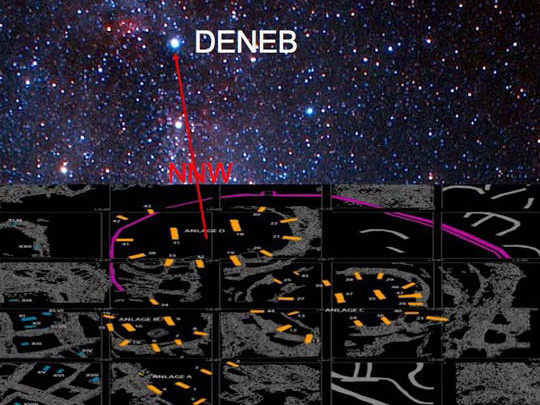
Deneb is the brightest star in the constellation Cygnus, the swan, also known
as the Northern Cross. Illustration © by Andrew Collins.
as the Northern Cross. Illustration © by Andrew Collins.
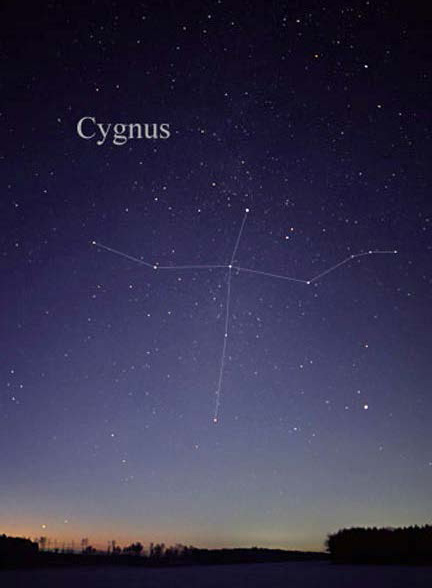
Photograph of the constellation Cygnus, the swan, or Northern Cross
with star Deneb at the top on January 23, 2004. Deneb is the brightest star
in the Cygnus constellation and one of the vertices of the Summer Triangle.
A blue-white supergiant, Deneb is the 19th brightest star in the night sky
in its apparent magnitude of 1.25; and at its absolute magnitude 8.4
is one of the most luminous stars known. Its exact distance (and hence
luminosity) has been difficult to calculate, so it is anywhere between 54,000
and 196,000 times as bright as our Sun. Image 2004 by Till Creder,
AlltheSky.com, The Netherlands.
with star Deneb at the top on January 23, 2004. Deneb is the brightest star
in the Cygnus constellation and one of the vertices of the Summer Triangle.
A blue-white supergiant, Deneb is the 19th brightest star in the night sky
in its apparent magnitude of 1.25; and at its absolute magnitude 8.4
is one of the most luminous stars known. Its exact distance (and hence
luminosity) has been difficult to calculate, so it is anywhere between 54,000
and 196,000 times as bright as our Sun. Image 2004 by Till Creder,
AlltheSky.com, The Netherlands.
Andrew Collins: “And it was this bright star that the main central pillars in all of the Gobekli enclosures seemed to be focused toward. This was something that was the beginning of my interest in this constellation. If you start looking into civilizations, risen and fallen around the world - both in the Old World and the New World - it is at the core of religious beliefs, at creation myths, of funerary myths. It seemed to be the point in the sky that was the point of cosmic creation, but also the place of death. The place where the soul would return to in death.
Why was this so important? For two reasons. Firstly, because this was the position on the Milky Way where the Milky Way splits into two, like forks into two (branches) to create what is known as the Dark Rift.
[...]
For the rest of the fascinating article regarding Gobekli Tepe and the Star Deneb, by Linda Moulton Howe, please visit EarthFiles.com
You can find Part 2: 12,000-Year-Old Gobekli Tepe - Was It A Soul Recycling Machine Linked to Deneb in the Cygnus Constellation? by Linda Moulton Howe.
© 2013 by Linda Moulton Howe, www.earthfiles.com
Tune into Red Ice Radio:
Linda Moulton Howe - Hour 1 - Baltic Sea Object, Göbekli Tepe & Creation of Homo Sapiens
Linda Moulton Howe - Hour 2 - Baltic Sea Object, Göbekli Tepe & Creation of Homo Sapiens
Andrew Collins - The Cygnus Mystery
Andrew Collins - The Cygnus Mystery Linked to Giza’s Underworld
Klaus Schmidt - Göbekli Tepe: The World’s Oldest Temple?
John Anthony West & Laird Scranton - Göbekli Tepe
